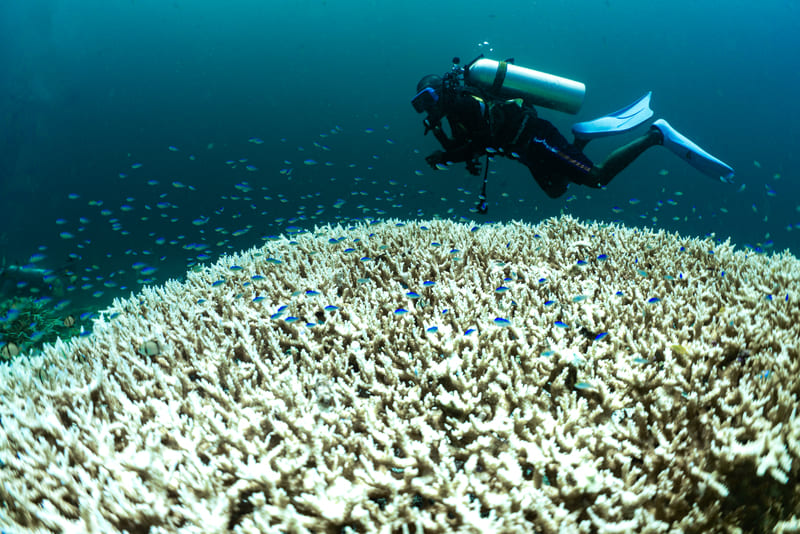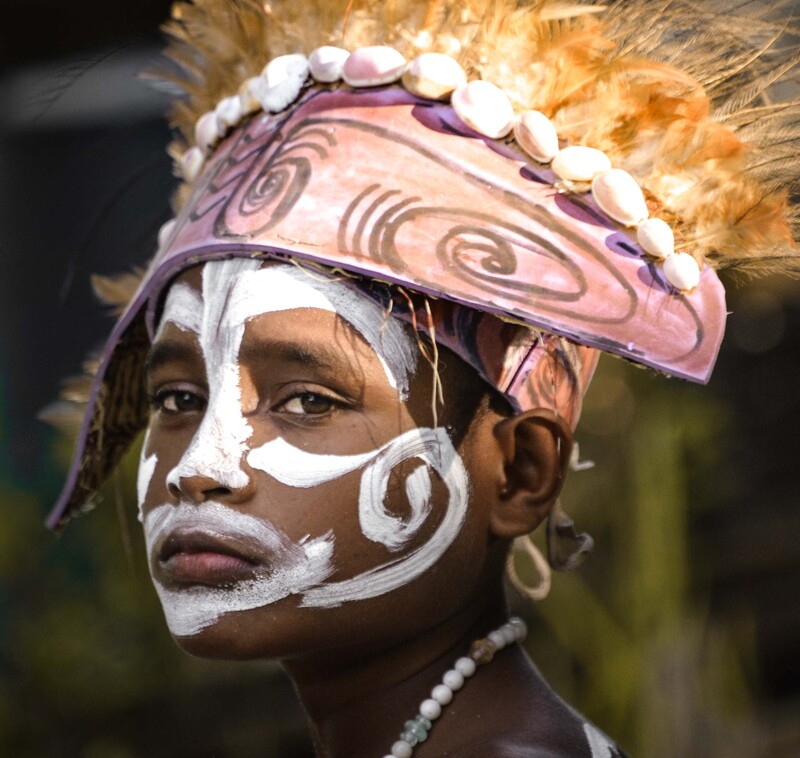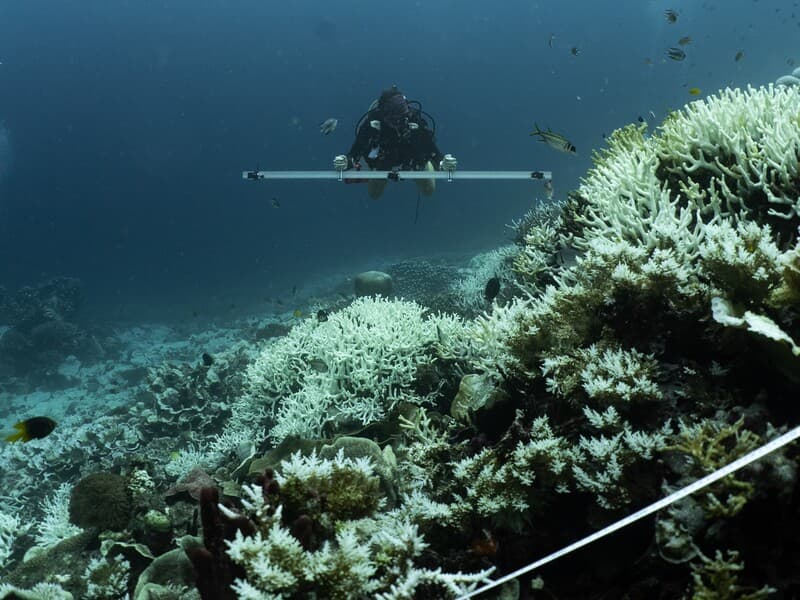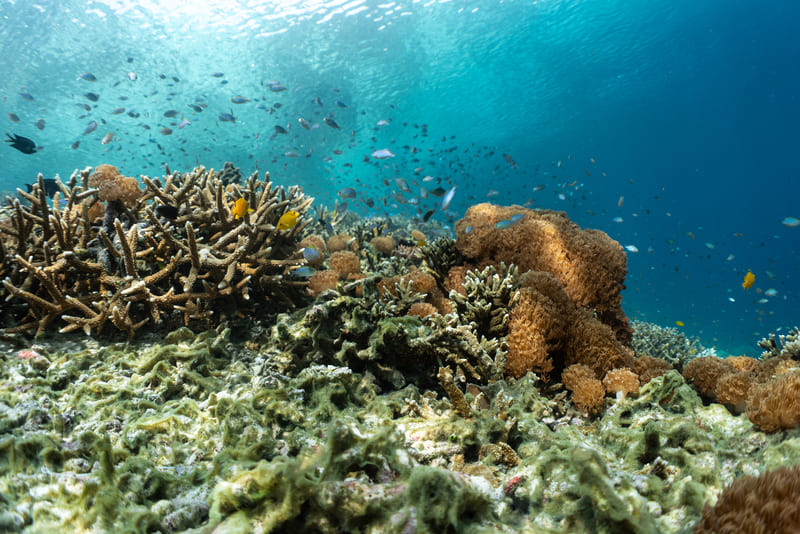For generations, the people here have lived in sync with the ocean, guided by ancestral knowledge passed down through time. But today, the changes they see – driven by human activity – are happening faster than even they can explain.
Raja Ampat’s 1700 islands, known to hold the most biodiverse reef ecosystems in the world, are scattered over the equator on the northeastern tip of Indonesia. Whales, manta rays, sharks, and thousands of fish species roam these waters. On the coral-fringed islands, life is simple, with a bucket of rainwater as a shower and electricity available only at night. In the heart of this archipelago lies Arborek Island, a tiny dot between the islands of Mansuar and Waigeo, hosting roughly 200 people. I have spent more than five years on this island, working closely with the local community and learning about this fascinating corner of the world while managing a marine conservation non-governmental organisation (NGO). When I first arrived in 2017, the island was a remote paradise with a few huts on stilts, bathing in sunshine.
Fast forward to my return in 2021, and the island had developed to welcome tourists with a few homestays – simple accommodation that is family-owned. Over the last four years, the coastline of Arborek has been divided up by 12 homestays, and liveaboards surround the island in high season. Tourists walk around the 20-hectare island looking for a cold beer, taking selfies with the local children and offending the community by walking around in bikinis and boardshorts.

The economic benefit of tourism for the region is evident, and tourism can certainly have a positive ripple effect on remote destinations such as Raja Ampat if managed properly. The Raja Ampat area is managed by the governmental body called BLUD, which manages the Marine Protected Areas and pledges to ensure sustainable tourism, environmental protection, and benefits for the local communities. The Raja Ampat region is the first to ban shark fishing and protect turtles, manta rays, and dugongs by law. The increased attention to the region, often dubbed ‘the last paradise’, has sparked interest in the protection of the precious coral reefs. Since 2010, many NGOs have started collecting data on the impressive ecosystems in order to understand them better, informing stakeholders and governments. Self-proclaimed eco resorts arrived too, most with a serious dedication to minimise their impact, the unparalleled biodiversity, and some with a commitment to restoring what has been lost through coral restoration and financial support towards local NGOs.
While tourism in Raja Ampat has brought an undeniable increase in environmental awareness, it has ironically left a mark not only on land. Among the most concerning is the rapid spread of cyanobacteria: ancient microorganisms that flourish in nutrient-loaded waters. With an overburdened sewage system unable to cope with increasing demand, and climate change intensifying rainfall and ocean temperatures, conditions are ripe for these blooms to thrive.
I’ve watched it happen firsthand: a once-thriving sea fan turning ghostly and pale within a week, buried beneath a living smog. Coral restoration frames offer little resistance. Then, just as suddenly, tides shift and the bloom drifts away—perhaps toward another vulnerable reef. Though light returns, the damage left behind often doesn’t heal. Cyanobacteria do not die and disintegrate like algae would but stubbornly outlive coral reef after coral reef.

In the field, scientists working in Raja Ampat began raising alarms as they observed an unsettling trend: cyanobacteria—normally present in small, manageable amounts—were appearing more frequently, spreading faster, and forming dense mats over once-thriving reefs. Their concern grew quickly. Dr Erika Gress, a marine ecologist who studies coral ecosystems from shallow reefs to the deep sea, was among the first to sound the alarm.
“I’ve watched cyanobacteria destroy entire tropical ecosystems before,” she tells me, her voice low as we sit on a jetty, the ocean glowing gold beneath the setting sun. “I saw it in the Caribbean as a child. Raja Ampat’s coral is resilient, but cyanobacteria will win at this rate. It’ll suffocate whole reefs within years. We don’t have time to lose.”
Erika spends much of the year on Arborek, drawn by its unusually abundant black coral—antipatharians—which she researches. Since we met in 2021, I’ve worked alongside her to help map these populations, and in early 2022, she pointed out the growing cyanobacterial presence. Together with Dr Josie Chandler, the head of science at the NGO I manage, we began actively monitoring the bloom.
“As soon as Erika mentioned it, I dove into the literature,” she said. “Turns out, this is serious.”
During a drift dive from Arborek’s northwest to its eastern reef, the full scale of the crisis came into sharp focus. What began as a swim through a vibrant, healthy coral ecosystem quickly dissolved into devastation—an eerie, uninterrupted expanse of green. Cyanobacteria had blanketed the reef, smothering corals so completely that it brought me to tears by the end of the dive. These blooms are especially dangerous to hard, reef-building corals, halting recovery when bleaching occurs.
In late 2024, central Raja Ampat experienced its first recorded mass bleaching event, potentially linked to cyanobacteria. These microorganisms deplete oxygen levels, creating hypoxic conditions that stress marine life and trigger coral bleaching. A bigger issue is the fact they smother already bleached coral colonies and prevent baby corals from settling and surviving, further crippling reef regeneration. To make matters worse, the toxins cyanobacteria release can harm fish and contaminate vital food sources, posing real health risks to local communities.

Using my fluency in Bahasa Indonesia and long-standing ties with Arborek villagers, I spoke with them about the white reefs. “Someone must’ve poured chemicals into the sea,” one said. “There are too many foreigners on the reef, it’s putting pressure on the coral,” added my neighbour. An elder offered another possibility: the seasons have shifted. “The wind comes late now. Nature is confused.” But when asked what chemicals, or exactly how people were affecting the reefs, everyone said the same thing: “tidak tahu” (don’t know).
Sitting on the deck of my overwater bungalow after a sobering dive through bleached reefs, Dr Josie Chandler and I reflect on the root causes of the crisis. “The problem is not sunscreen or breakage of corals by irresponsible divers, but without question, the major issue is the increase in human sewage,” she says. Basic pit toilets once served small island populations without harming ecosystems, but tourism has outpaced the capacity of these systems. New beachside toilets near the shoreline speed up the flow of waste into the sea, bypassing natural filtration through soil, while untreated sewage discharged from liveaboards worsens the situation.
“Liveaboard operators have a lot to answer for,” Chandler continues. “Their solutions are more straightforward than island-based operations […] but, ultimately, the cost of losing Raja Ampat reefs would be a lot more expensive.”
Managing a team of remote scientists, Chandler has overseen nearly two years of cyanobacteria monitoring around Arborek and leads photogrammetry reef mapping projects in collaboration with NOAA to learn more about the recent bleaching events.
“The problem with cyanobacteria is that stopping the blooms is a huge task,” she explains. “It demands all stakeholders – villagers, resorts, liveaboards, and homestays – to come together.” Without urgent reform, she warns, “bleached reefs’ chances to recover are minimal once smothered by cyanobacteria, and the cyanobacterial blooms are only getting bigger and more frequent.”

The most clean-cut way to tackle the wastewater issue is to install bio tanks with a drainage system attached, absorbing all nitrogen out of the wastewater before it enters the soil and eventually reaches the ocean. These treatment systems need to be installed across Raja Ampat, including family housing, homestays, resorts and liveaboard vessels.
Chandler, who visited Raja Ampat for the first time in 2017, says, “It would be heartbreaking to see the most biodiverse reefs in the world succumb under the weight of preventable anthropological stressors like wastewater and overtourism.” She has sent numerous alerts to BLUD and the regional government to convince them that this issue would become worse if not acted upon as soon as possible. The alerts, accompanied by persuasive datasets, were ignored. The government and MPA seem disconnected from the coral reefs they promised to protect, forgetting that without these thriving reefs, the tourism industry would suffer a detrimental hit.
The polarisation between government officials and stakeholders seeking urgent measures was stark at a stakeholder meeting in Sorong this January. A presentation illustrating the wastewater problem was provided by Wawan Mangile, senior manager at The Nature Conservancy. Yusdi Lamatenggo, head of the Tourism Agency, dismissed the notion that the state bears responsibility for managing waste. “Waste is not the responsibility of the state. We are all on this earth,” he said, before quickly shifting the conversation. He also rejected claims that Raja Ampat is experiencing overtourism, stating, “Where is the ‘overtourism’? Where? We only use 3% of the land, while it should be 30%.”
Meanwhile, BLUD Head Syafri Tuharea acknowledged the environmental impact of sewage but downplayed its long-term consequences. “I saw a bleached coral reef in 2018, completely white, but three months later it recovered,” he remarked, though he did promise to release updated water testing data, months after Chandler had already shared her findings.
The meeting was heavy on promises of “collaboration,” though several participants were sceptical. Some saw the language as a way to deflect governmental accountability. Syafrudin Sabonama, chair of the PAN Regional Executive Board for Southwest Papua, called for firmer action: “Don’t just talk about collaboration while turning a blind eye. This forum cannot simply be a happy story after a meeting. Our NGO friends bring in foreign resources and funding, work hard, and are ignored. Don’t let someone else do the work, and the government takes the credit.”
One homestay owner also challenged official narratives on reef bleaching: “Some say the bleaching is just a seasonal change, but what season kills the reef and leaves nothing behind? This isn’t nature’s cycle; it’s a disaster we’ve failed to confront.”
Any opinions expressed in this article are those of the author and do not necessarily reflect the views of Indonesia Expat.




